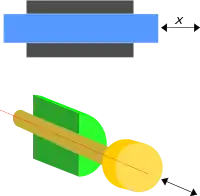Prismatic joint
A prismatic joint is a one-degree-of-freedom kinematic pair[1] which constrains the motion of two bodies to sliding along a common axis, without rotation; for this reason it is often called a slider (as in the slider-crank linkage) or a sliding pair. They are often utilized in hydraulic and pneumatic cylinders.[2]

Prismatic joint seen in 2-dimensional form. Only linear motion is possible. In contrast to a revolute joint the axis is prevented from rotating (this can be accomplished by giving the axis a prismatic shape which is not visible here).
A prismatic joint can be formed with a polygonal cross-section to resist rotation. Examples of this include the dovetail joint and linear bearings.
See also
References
- Norton, Robert L. (2008). "2". Design of Machinery (4th ed.). Boston, MA: McGraw Hill Higher Education. p. 33. ISBN 978-0-07-312158-1.
- Robotics Research Group. "Joint Types". University of Texas at Austin. Archived from the original on 2009-03-11. Retrieved 2009-02-04.
This article is issued from Wikipedia. The text is licensed under Creative Commons - Attribution - Sharealike. Additional terms may apply for the media files.